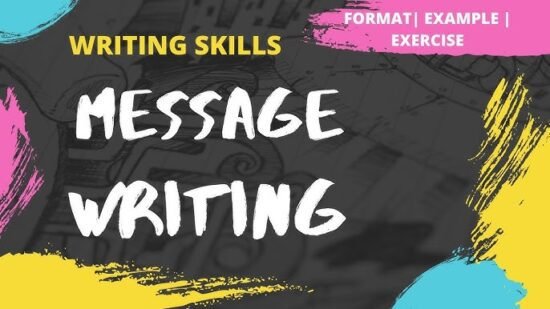
Message Writing for Class 7th English
- Posted by Dileep Gautam
- Categories 7th English
- Date April 3, 2025
- Comments 0 comment
- Tags Effective Communication, Message Writing, Persuasive Writing, Professional Messaging, Social Media Messaging, Writing Skills, Writing Tips
Notes on Message Writing for Class 7th English

Introduction to Message Writing
Message writing is a short, informal way of communicating important information to someone when you cannot speak to them directly. It is a practical skill used in everyday life, such as leaving a note for a family member, friend, or teacher. In Class 7th English, message writing is introduced to help students learn how to convey information clearly, concisely, and politely in written form.
A message is usually written when:
- The person you want to inform is not available at the moment.
- You need to pass on urgent or important information quickly.
- You want to ensure the person gets the details even if you cannot meet them.
For example, if your friend calls your home and you are not there, your sibling might write a message for you with the details of the call.
Features of a Message
- Short and Simple: A message should be brief and to the point. Avoid unnecessary details.
- Clear: The information should be easy to understand.
- Polite Tone: Even if the message is urgent, it should be written politely.
- Informal Language: Since messages are usually for people we know, the language can be casual but respectful.
- Purposeful: Every message has a specific reason, like informing, requesting, or reminding.
Format of a Message
In Class 7th English, students are taught a standard format for message writing to ensure clarity and uniformity. The format includes the following parts:
- Heading:
- Write the word “MESSAGE” at the top center of the page in capital letters. This tells the reader immediately what the note is.
- Date:
- Write the date below the heading. For example, “April 2, 2025”. This helps the receiver know when the message was written.
- Time:
- Mention the time the message was written, such as “10:30 AM”. This is useful for urgent messages.
- Salutation:
- Address the person for whom the message is intended. For example, “Dear Mom”, “Dear Ravi”, or “Dear Sir”. Use a name or relation depending on the situation.
- Body:
- This is the main part of the message. Write the information clearly and briefly. Include:
- Who the message is from (if applicable).
- What the message is about (the key information).
- Any action required (e.g., “Please call back”).
- Keep it to 2-3 sentences if possible.
- This is the main part of the message. Write the information clearly and briefly. Include:
- Closing:
- End with your name or signature. For example, “Riya” or “Your sister”. This tells the receiver who wrote the message.
Sample Format
MESSAGE
Date: April 2, 2025
Time: 10:30 AM
Dear [Receiver's Name],
[Body of the message: Write the key information here.]
[Your Name]
Guidelines for Writing a Good Message
- Stick to the Word Limit: In exams, there might be a word limit (e.g., 50 words). Practice writing concise messages.
- Use Simple Words: Avoid complex vocabulary. The goal is to make the message easy to read.
- Be Specific: Include important details like names, times, or places so the receiver understands fully.
- Avoid Long Stories: Do not explain unnecessary background details. Focus on the main point.
- Check Grammar: Use correct tenses and punctuation to avoid confusion.
Examples of Message Writing
Example 1: Message for a Family Member
MESSAGE
Date: April 2, 2025
Time: 3:00 PM
Dear Mom,
Aunt Rita called to say she will visit us tomorrow at 5:00 PM. She asked you to call her back when you’re free.
Riya
Explanation: This message is short, includes who called, the purpose, and a request to call back. It’s written in a polite and clear way.
Example 2: Message for a Friend
MESSAGE
Date: April 2, 2025
Time: 11:00 AM
Dear Sameer,
Our teacher said the science project is due on Friday instead of Monday. Please finish your part by tomorrow.
Amit
Explanation: This message informs the friend about a change in deadline and requests action. It’s direct and to the point.
Example 3: Message for a Teacher
MESSAGE
Date: April 2, 2025
Time: 9:15 AM
Dear Sir,
The principal called you to her office for a meeting at 10:00 AM today. Please be on time.
Priya (Class Monitor)
Explanation: This is a formal yet simple message with key details (who, what, when) and a polite tone.
Common Situations for Message Writing
- Phone Calls: When someone calls and the person they want to speak to is not available.
- Example: “Your friend called to say the picnic is canceled.”
- Reminders: To remind someone about a task or event.
- Example: “Don’t forget to bring your books tomorrow.”
- Requests: Asking someone to do something.
- Example: “Please buy milk on your way home.”
- Urgent News: Sharing important updates quickly.
- Example: “The doctor’s appointment is rescheduled to 4:00 PM.”
Tips to Score Well in Exams
- Follow the Format: Always include the heading, date, time, salutation, body, and closing.
- Stay Within Word Limit: If the question specifies a limit (e.g., 50 words), count your words and stick to it.
- Use the Given Information: In exams, you might get a situation or conversation. Use only the details provided, and don’t add extra ideas.
- Write Neatly: Present your message clearly so the examiner can read it easily.
- Practice: Write messages for different situations to improve speed and accuracy.
Practice Questions
- Your friend calls to say the football match is postponed to next week. Write a message for your brother who is not at home.
- Your teacher asks you to inform your classmate about a surprise test tomorrow. Write a message.
- Your mother leaves a note asking you to inform your father about a family dinner at 7:00 PM. Write the message.
Common Mistakes to Avoid
- Forgetting the Format: Skipping the heading, date, or time can cost marks.
- Writing Too Much: A message is not an essay. Keep it short.
- Using Rude Language: Even if you’re upset, maintain a polite tone.
- Missing Key Details: Forgetting to mention who the message is from or what it’s about makes it incomplete.
- Spelling Errors: Simple mistakes can confuse the reader.
Why Learn Message Writing?
Message writing is a life skill. In today’s world, we may use text messages or emails, but the idea remains the same: sharing information quickly and clearly. For Class 7th students, it also helps improve:
- Writing skills (grammar, sentence structure).
- Communication skills (being clear and concise).
- Creativity (thinking of how to phrase a message).
Conclusion
Message writing is an essential part of English learning in Class 7th. By following the format and practicing regularly, students can master this skill. It’s not just about passing exams but also about being able to communicate effectively in real life. Whether it’s a note for a parent, a friend, or a teacher, a well-written message ensures the information reaches the right person at the right time.
Download pdf notes and Sulutions of the Chapter:
Please Visit Readspot for Hindi Medium Study Material
Welcome to eStudyzone, your ultimate destination for academic excellence and learning enhancement! Founded by Dileep Gautam, eStudyzone is committed to providing students with the tools and resources they need to succeed in their educational journey.
You may also like

Informal Letters (Class 7 English)

Best Notice Writing Format and Templates

